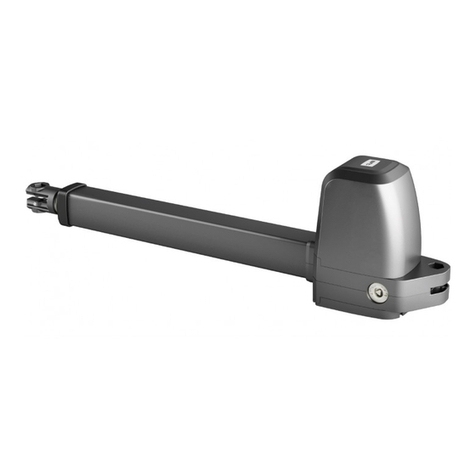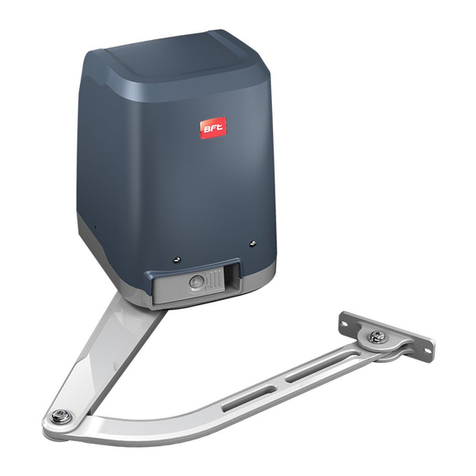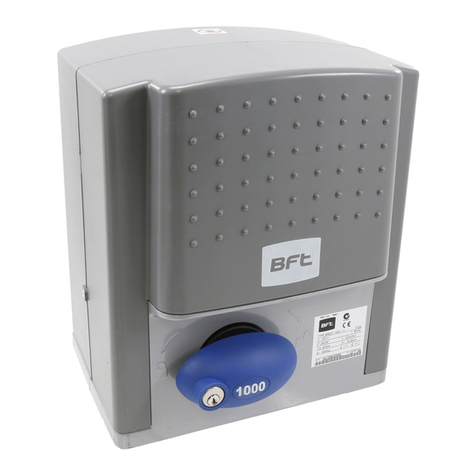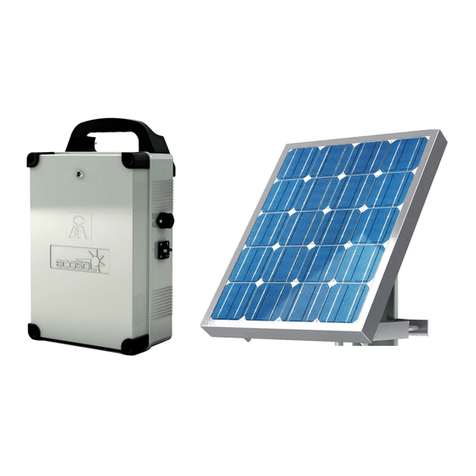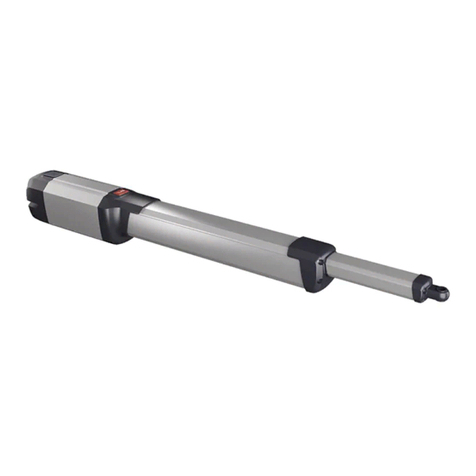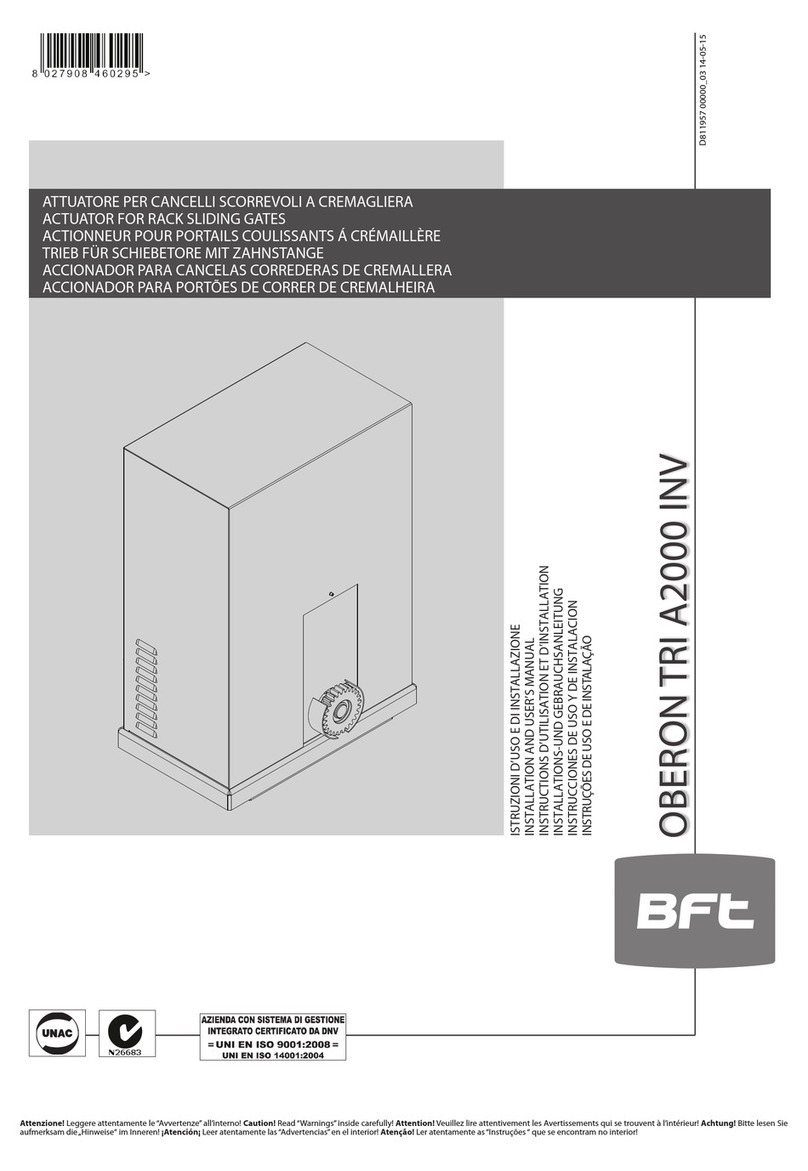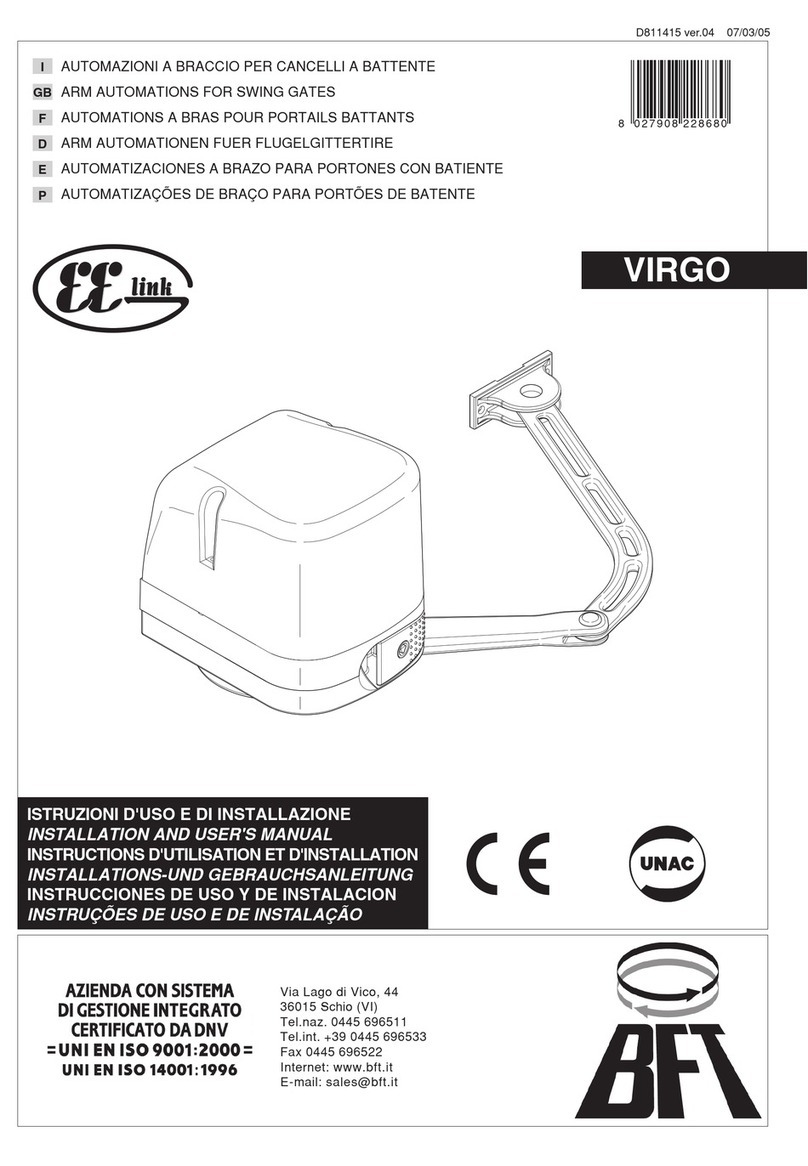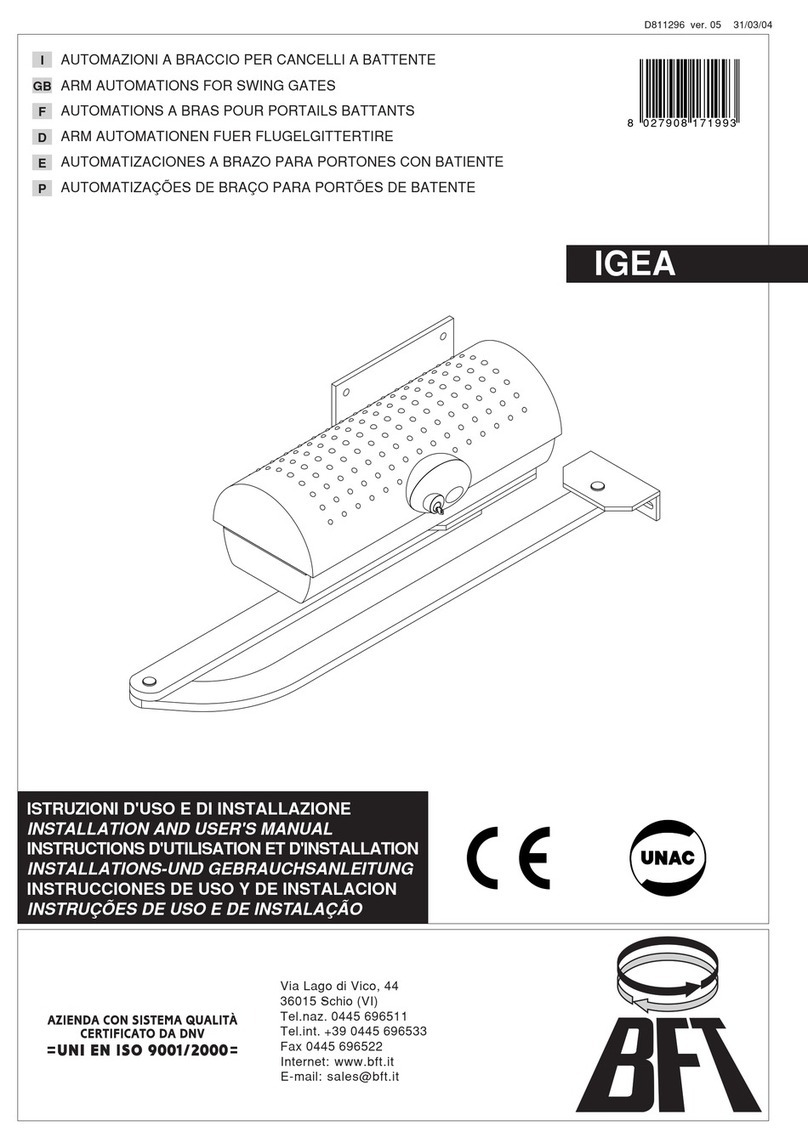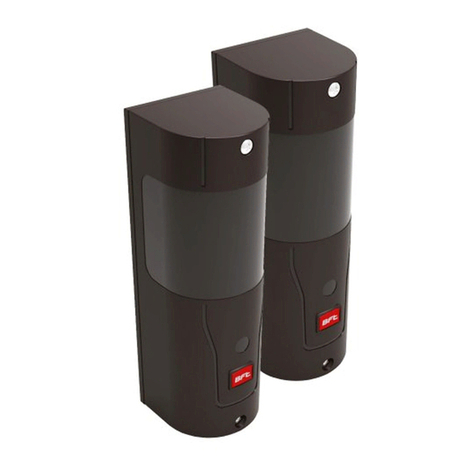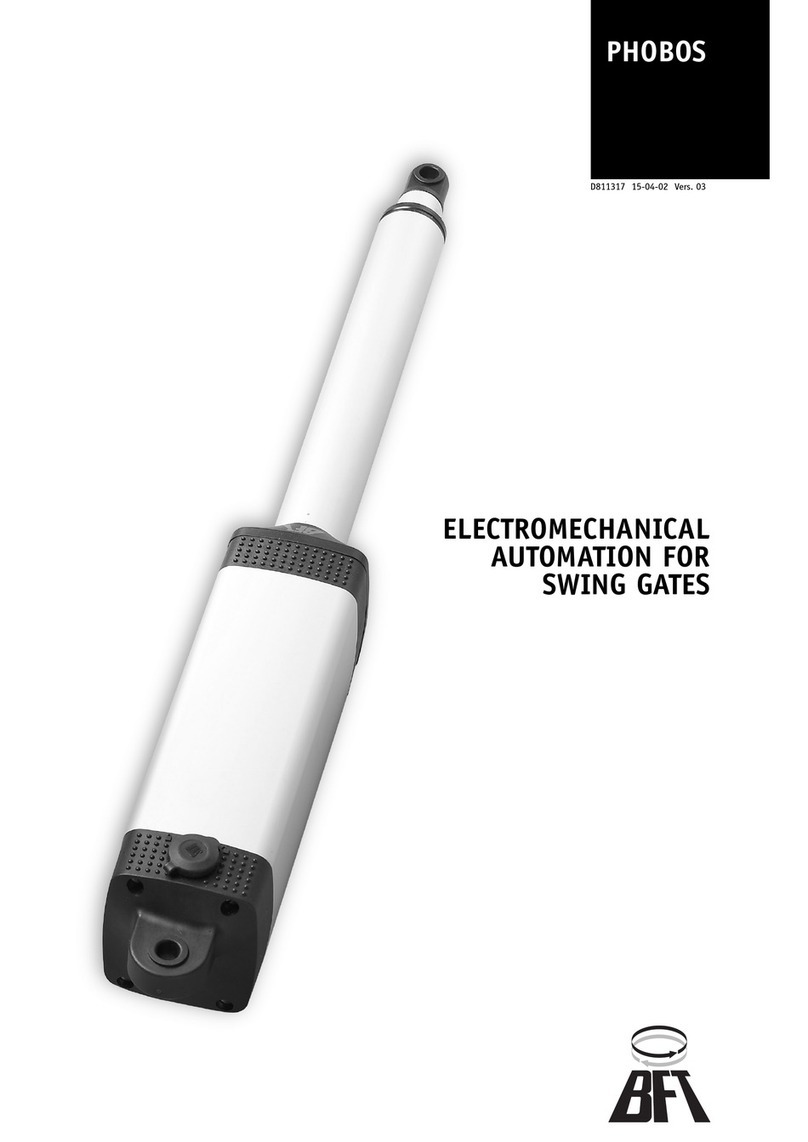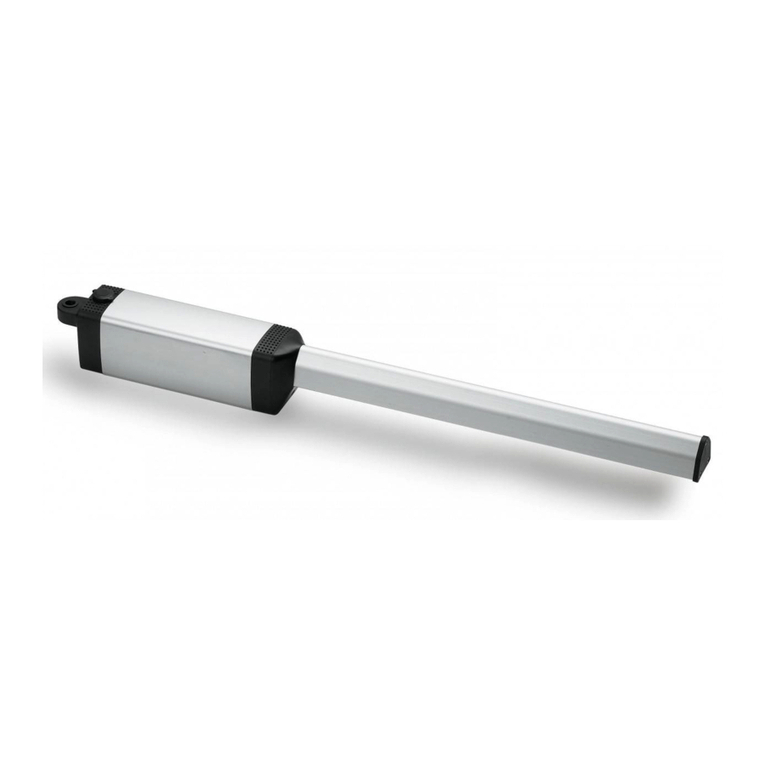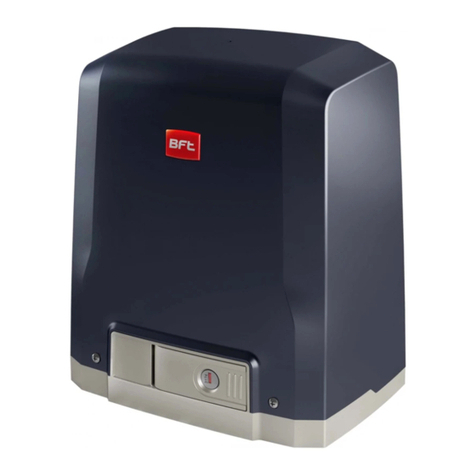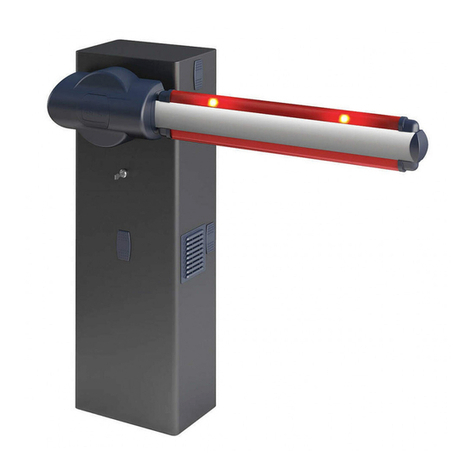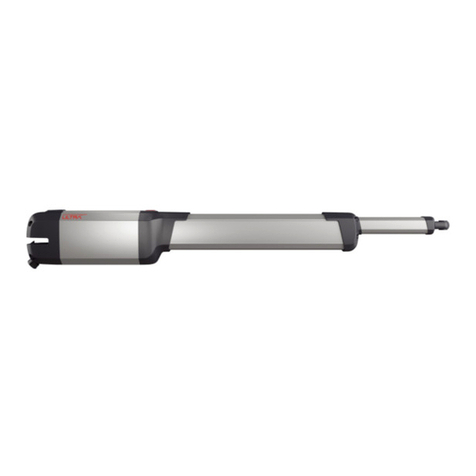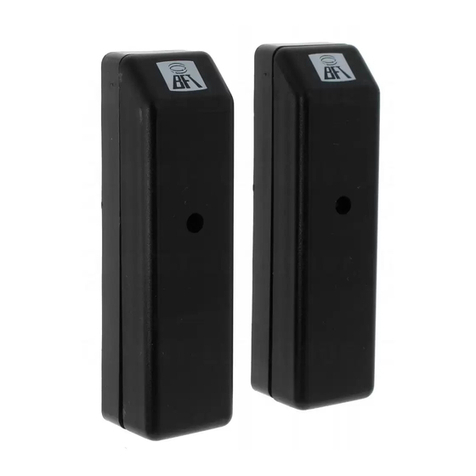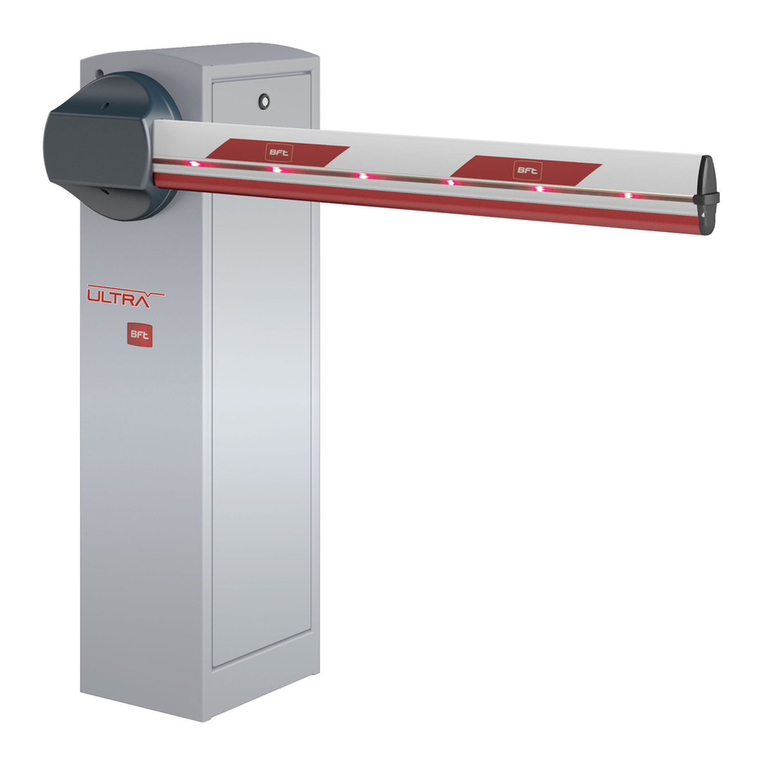Qr) Control panel and built-in receiver.
S) Key selector.
AL) Blinker with tuned antenna.
M) Actuator.
E) Electric lock (compulsory for leaves longer than 2,5m).
Fte) Pair of external photocells (transmitter section).
Fre) Pair of external photocells (receiver section).
Fti) Pair of internal photocells with CF posts (transmitter section).
Fri) Pair of internal photocells with CF posts (receiver section).
T) 1-2-4 channel transmitter.
RG58)
Cable for antenna.
D) Connector block.
5.3) Electrical installation set-up
Lay out the electrical installation as shown in fig. 2, with reference to the CEI
64-8 and IEC 364 provisions, complying with the HD 384 and other national
standards in force for electrical installation. The mains power supply
connections must be kept totally separate from the service connections
(photocells, electric edges, control devices etc.).
WARNING! For connection to the mains, use a multipolar cable with
a minimum of 3x1.5mm2cross section and complying with the
previously mentioned regulations. For example, if the cable is out side
(in the open), it has to be at least equal to H07RN-F, but if it is on the
inside (or outside but placed in a plastic cable cannel) it has to be or
at least egual to H05VV-F with section 3x1.5mm2.
Connect the control and safety devices in compliance with the previously
mentioned electrical installation standards. Fig. 2 shows the number of
connectionsand the cross section for cables having a length ofapproximately
100 metres; in case of longer cables, calculate the cross section for the
actual automation load.
Warning! For actuator wiring and accessory connection, refer to the
relevant instruction manuals. The control panels and accessories must be
suitable for use and conform to current standards.
5.4) Foundation case cementing
The foundation case must be cemented under the hinge pivot, taking into
consideration that the actuator bearing shaft must be perfectly aligned with
the leaf rotation axis. If the gate has fixed hinges, remove the gate and the
lower hinge. If the leaf is sufficiently separated from the ground and cannot
be removed, proceed to supporting it by means of a shim placed between
the ground and the leaf during installation. If the gate has adjustable hinges,
remove the lower one, slacken the upper hinge and move the leaf to the
side. If the gate has been recently installed, fit an upper adjustable hinge.
Dig a foundation hole having the dimensions specified in fig.4. Lay an drain
pipe (fig. 4) for rainwater in order to prevent it from being collected inside
the foundation case. Lay a raceway for the power supply cable as far as
connector block “D”. Lay a solid foundation (fig.3) at the bottom, where to
bury the foundation box. To obtain good squareness between cases and
leaves, set out their alignment using a stretched rope between the 2 bearing
pivots, and aligning the 2 reference points “C”with each other (see fig.12).
Let the cement harden for the time needed.
6) GATE LEAF FITTING
•Abundantly grease the pivot in the foundation case.
•Position the lever assembly by inserting pipe “A”into the pivot of the
foundation case, as in fig.9. If the height of the assembled levers is not
sufficient, insert shim “S”between the assembled lever unit and the gate
leaf, as in fig.5.
•Place the gate leaves in the closing and in the closed position against
the centre stop plate.
•Perfectly align the assembled lever unit to the hinge.
•If a shim is used, weld it to the leaf first and then weld the lever unit
to the shim.
•Check the leaf operation.
•If the gearmotor is not to be installed, fit the foundation case cover and
fix with suitable screws.
At this stage, the gate opens and closes manually. All that remains to be
done is to position the gearmotor.
7) GEARMOTOR FITTING
Remove the nuts from the bottom of the case using a CH19 socket wrench.
The gearmotor is to be fixed to the foundation case in the position shown
in fig.6 and 8, using the 4 nuts which were previously removed.
•Tighten screws ”VR”(fig.7) and respective locknuts to the end-of-stroke
brackets and identify the left or right fastening position (fig.8).
•Fix the mechanical end-of-stroke brackets using the M8 screws
provided (fig.7).
•Fit the motor-pivot connecting lever components following the correct
sequence given in fig.9.
In the case where the position of the levers interferes with the
assembly of the components, supply the motors with current (by
means of the control unit) until the levers reach the required position.
•Grease the hub where pipe “A”must be inserted.
•Check the opening and closing operations.
•Attach to the leaf the internal and external release labels observing the
direction and position indicated in fig.14. The open-padlock symbol
must always be directed towards the leaf rotation axis.
8) END-OF-STROKE ADJUSTMENT
If no ground stop plates “FA”are fitted, adjust the internal stops using the
screws “VRC-VRO”(fig.10-11) until the leaf stops at the required point.
The mechanical stop for the opening and closing operations can be
adjusted by means of the appropriate screws “VRC-VRO”.
•On CLOSING (fig.10): The end-of-stroke adjusting screw “VRC”should
come into contact with lever “L”after the leaf has reached the centre stop
plate “FA”(fig.8). This guarantees that the leaf rests against the centre
stop plate “FA”which, if provided with a rubber cap, avoids banging
noises. In the case where, during the adjustment of the end-of-stroke
stop “VRC”, measurement “Z”(fig.8) becomes greater than 18÷20 mm,
the stop should be turned as in fig.13a.
•On OPENING (fig.11): The end-of-stroke adjusting screw “VRO”must
come into contact with lever “L”after the leaf has reached the centre stop
plate “FA”(fig.8).
•After completing the adjustment, tighten the locknut on the end-of-
stroke adjustment screws “VRO”together with the screw tightening the
end-of-stroke dowel “VRC”.
•Repeat the same procedure for the second actuator.
•If the foundation case is not orthogonal to the leaf, a 10% adjustment can
be carried out both in clockwise and anticlockwise directions, by
positioning the support bracket and the stop plate as shown in fig. 13b.
9) MOTOR TORQUE SETTING
CAUTION! When using the ARIES mod. control unit with the torque set to
“F4”(maximum torque), it is compulsory to fit the ground stop plates “FA”
both on opening and closing.
The motor torque (antisquash) setting takes place in the control unit. See
the control unit instruction manual. The wiring diagram of the motor is
included in the instructions for use for the relative control unit. This setting
must be calibrated according to the minimum force needed to carry out the
complete opening and closing strokes, and always within the limits provided
for by current standards.
WARNING: Check that the impact force value measured at the
points established by the EN 12445 standard is lower than that
specified in the EN 12453 standard.
CAUTION! Excessive torque setting can jeopardise antisquash safety. On
the contrary, insufficient torque setting may not guarantee a correct
opening or closing stroke.
10) EMERGENCY MANOEUVRE
Emergency release is obtained by using the key provided, on the release
unit which is located under the gate, on the protruding section of the lever-
pivot. To release, insert the key in the release triangle and turn it by about
90°in the direction shown by the open-padlock symbol (fig.14). If the leaf
is equipped with an electric lock, release the electric lock as well.
To open/close the gate, push it manually. To restore motor-driven operation,
reposition the gate by aligning it with the lever bearing the lock unit, and turn
the key in the direction shown by the closed-padlock symbol (fig.14) checking
that engagement is correctly restored. Keep the leaf release key (and that
of the electric lock, if any) in a place which is known to the users.
11) AUTOMATION CHECK
Before making the automation fully operational, carefully carry out the
following procedure:
•Check that all components are tightly fixed.
•Check the correct operation of all safety devices (photocells,
electric edges etc.).
•Check the emergency manoeuvre command.
•Check the opening and closing operations with the control
devices provided.
•Check the standard or customised electronic function logic.

